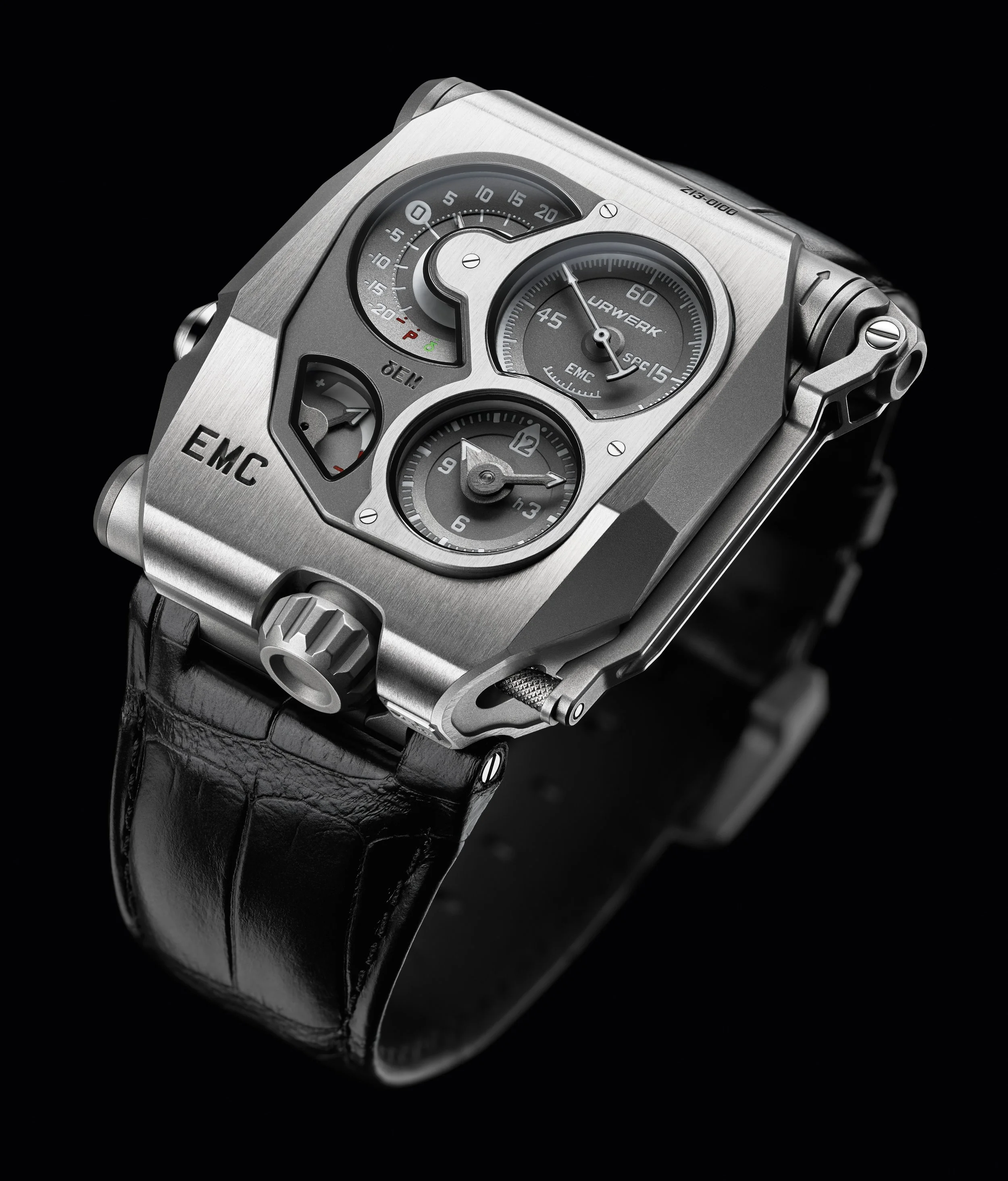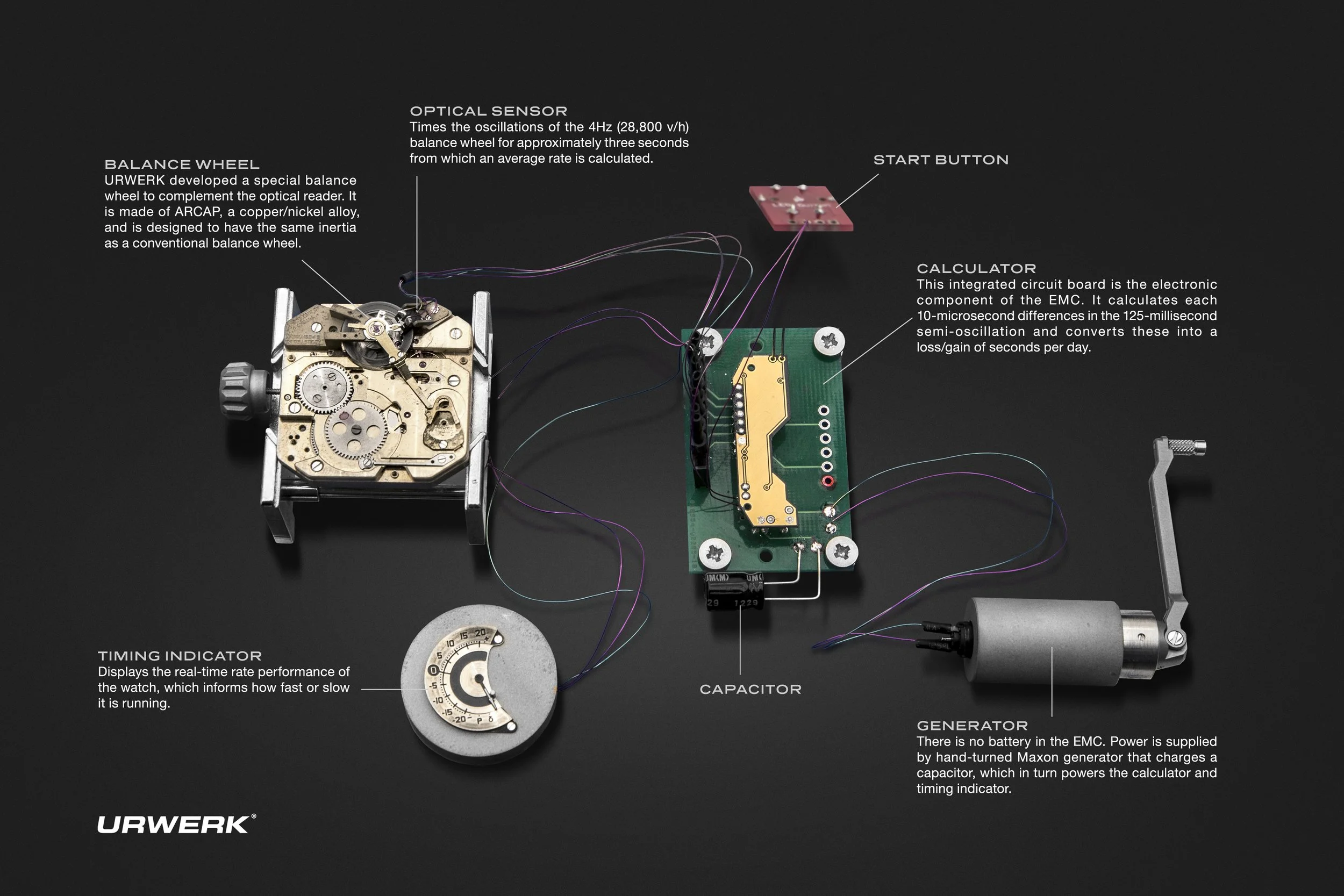Fantastic calibers and where to find them: Urwerk’s EMC
It’s not our first foray into the importance of Urwerk and its creations. The brand’s bedrock timepiece, the UR-103, established the brand’s signature mechanism in the satellite wandering hour and maintains icon status in modern independent watchmaking. That timepiece solidified the birth of a new aesthetic and design movement in watchmaking alongside the creations of De Bethune, Harry Winston’s Opus Collection, Vianney Halter, and then MB&F a few years later. With sci-fi overtones, the domination of “classical” aesthetics in high-end watchmaking ended.
While the UR-103 is one of the pillars in modern independent watchmaking, we consider the most innovative timepiece from Urwerk to be the EMC. Particularly, the EMC’s mechanics stand out in a catalog full of exceptionally noteworthy watches . Even after its release a decade ago, it still feels years ahead of its time. That’s why we’re diving deep into the EMC, its movement, and its place in the history of modern watchmaking.
Urwerk’s EMC released in 2014
Unpacking the EMC’s movement
To fully understand the EMC (standing for “Electro-Mechanical Control”), we have to return to one of Urwerk’s major themes across all of the brand’s timepieces. Co-founders Martin Frei and Felix Baumgartner are fundamentally interested in exploring how collectors can interact with mechanical watches in exciting, novel ways. The massive crown, use of exceptional materials, even textures on timepieces like the UR-105 T-Rex, all serve the purpose of providing the wearer with a tactile experience far beyond norms.
In line with the brand’s core pursuit, innovative mechanics lead to ultra-creative interactivity with the EMC. Urwerk wanted a way to measure and visualize the chronometric performance of a timepiece on the wrist. Hours and minutes are shown on the right side of the dial, while the top left side indicates the real-time plus-minus in seconds across the day. How the brand crafted this complication is something straight out of sci-fi novels.
The inner workings of the highly innovative EMC
We see in the EMC movement, a miniature computer that ties together a precision optical sensor, a 16 million hertz oscillator, and a micro-generator to power the calculator for chronometric accuracy. In greater detail, an optical sensor is linked to the balance wheel. This sensor consists of a transmitter and a receiver positioned on either side of the balance. Its role is to record the oscillations of this organ operating at 28,800 VPH (4 Hz) over a period of three seconds. This measurement is triggered manually by pressing a start button with the micro-generator powered by the crank attached to the top right of the case. Notice, this is an entirely independent mechanism – only the fully mechanical movement is used for timekeeping in the EMC. A 16,000,000 Hz electronic oscillator is used as the benchmark for comparison with the mechanical. The differential between the mechanical movement and the reference oscillator is calculated on an integrated circuit with each millisecond difference between the two is expressed as one second gained or lost over the course of 24 hours.
EMC Monitor: Optical sensor governed by an integrated circuit; 16,000,000 Hz reference resonator. Enabling the reading of a precision timer and amplitude.
For Urwerk, it’s not enough to simply measure and visualize the chronometric performance of the watch. Sure, that alone is an extraordinary feat (especially in the way the EMC accomplishes its task), but if the movement is running fast or slow, the wearer will want to do whatever’s needed to ensure that the timepiece is beating as accurately as possible. This is where the pursuit of novel interactions enters the picture. On the backside of the EMC, there’s a timing adjustment screw that allows for the wearer to make fine adjustments by modifying the active length of the balance spring. Martin and Felix have taken the tools, usually highly technical and reserved for the watchmaker’s bench, and placed power into the wearer’s hands to make their own necessary adjustments.
All of this, released in 2014, was so mind-blowing that it won two GPHG Awards – one for Mechanical Exception (most special mechanism) and another for Innovation. The EMC is one of the very few timepieces to take home multiple awards in the same night. This speaks to how truly mind-bending this watch was on arrival.
Currently in-stock, pre-loved EMC Time Hunter X-Ray
What makes the EMC movement so special?
Such a big question has a remarkably simple answer: the EMC is years ahead of its time.
The EMC is a new-age ode to the core, historical values of mechanical watchmaking. The ultimate pursuit in mechanical watchmaking is accurate timekeeping. The reality of that pursuit is, everyday conditions from positional changes to hot and cold temperatures to pressure in the environment, all impact chronometric performance. There’s no singular solution for “accurate timekeeping” in the chaos of life. The only way to truly present a mechanical watch to its wearer with a high level of accuracy is to know how it’s performing in real-time and provide a way to make adjustments as needed.
Mechanical ingenuity in the EMC’s in-house movement
With the EMC delivering on both, it feels as if this watch is at the very end of mechanical watchmaking or at its very limit. The marriage of mechanics and electronics, the analog and digital, without sacrificing the classical watchmaking tradition at the altar of quartz movements. In philosophy circles, there’s a joking comment that Hegel waits for us all at the end of history. As far as the pursuit of chronometry is concerned, it feels like the EMC is doing something very similar to Hegel for all other mechanical timepieces. Mechanical chronometers of the future will require a self-monitoring system with an outside benchmark.





